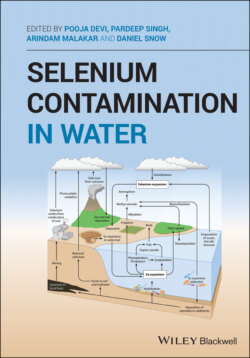Читать книгу Selenium Contamination in Water - Группа авторов - Страница 42
3.4.2 Aquatic and Terrestrial Life
ОглавлениеSe concentrations characteristically are higher in oceanic organisms than in those from river ecosystems, and they are greater in areas having seleniferous soils or deposits along with the areas with industrial, agricultural, or municipal wastes dump sites. It is observed that the egg‐laying vertebrates, namely fish and water birds, are the most sensitive organisms and could be at greatest risk in Se‐contaminated environments. These organisms at the base of the food web have been detected to concentrate Se 102 to 106 times exceeding that present in the water column (Sharma et al. 2017). There are some reports of high levels of Se in fish, primarily from seleniferous areas of the western United States and from reservoirs contaminated by fly ash from combustion of coal. The transfer of organic Se to eggs in egg‐laying vertebrates results in the production of reactive species that can cause not only oxidative stress but cellular dysfunction, which results in embryo mortality or teratogenic malformations observed in fish larvae and its population reduction (Chapman 2009).
Industries such as mining, agriculture, and petrochemicals discharge the waste generated by different operations into the water bodies, which causes contamination of Se in water. Generally the Se background concentrations in terrestrial invertebrates is found to be 0.1–2.5 mg/kg. Earthworms were found to bioaccumulate elevated concentrations of Se from selenite‐enriched soil (up to 7.5 mg Se/kg). There are fewer reports regarding terrestrial habitat, Se bioaccumulation, and toxicity.
The USEPA recently recommended strict guidelines for water quality criterion for the protection of aquatic life: 1.2 μg/l in lentic ecosystems (still freshwater) and 3.1 μg/l in lotic ecosystems (Holmes and Gu 2016). These new stringent guidelines may be useful for the protection of aquatic and terrestrial life from Se contamination.
